window OLDSMOBILE BRAVADA 1998 Owners Manual
[x] Cancel search | Manufacturer: OLDSMOBILE, Model Year: 1998, Model line: BRAVADA, Model: OLDSMOBILE BRAVADA 1998Pages: 380, PDF Size: 19.2 MB
Page 11 of 380
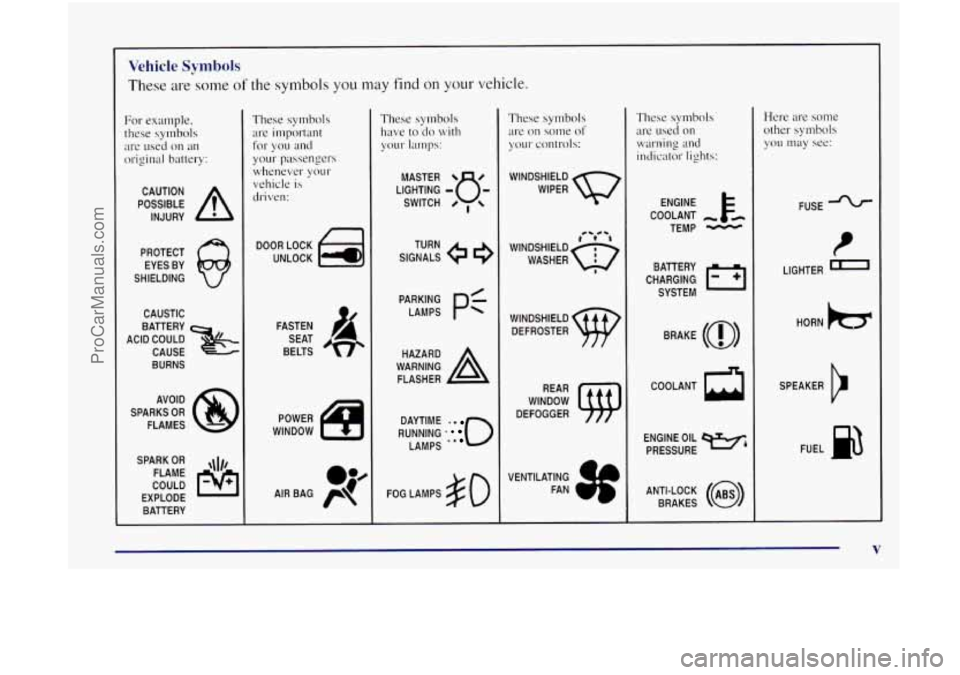
Vehicle Symbols
These are some of the symbols you may find on your vehicle.
For example,
these symbols
are used on
an
original battery:
POSSIBLE A
CAUTION
INJURY
PROTECT EYES BY
SHIELDING
CAUSTIC
ACID COULD
x
BATTERY
CAUSE
BURNS
AVOID
SPARKS
OR
FLAMES
SPARK
OR ,\I/,
COULD
FLAME
EXPLODE BATTERY
These symbols
are important
your passengers
whenever your
vehicle
is
driven:
for
you and
FASTEN
SEAT
BELTS
These symbols
have
to do with
your lamps:
SIGNALS 9
TURN
RUNNING
' 0
DAYTIME .
LAMPS **
FOG LAMPS $0
These symbols
are on some
of
your controls:
WINDSHIELD
WIPER
CS 0b
WINDSHIELD DEFROSTER
WINDOW
DEFOGGER
VEN TlLATlNG
FAN
These symbols are
used on
warning and
indicator lights:
COOLANT -
TEMP -
CHARGING BAllERY
SYSTEM
BRAKE
(0)
COOLANT a
ENGINE OIL w,
PRESSURE
Here are some
other symbols
you may see:
FUSE
LIGHTER
n
HORN )tr
SPEAKER
b
FUEL p3
ANTI-LOCK (@)
BRAKES
V
ProCarManuals.com
Page 36 of 380
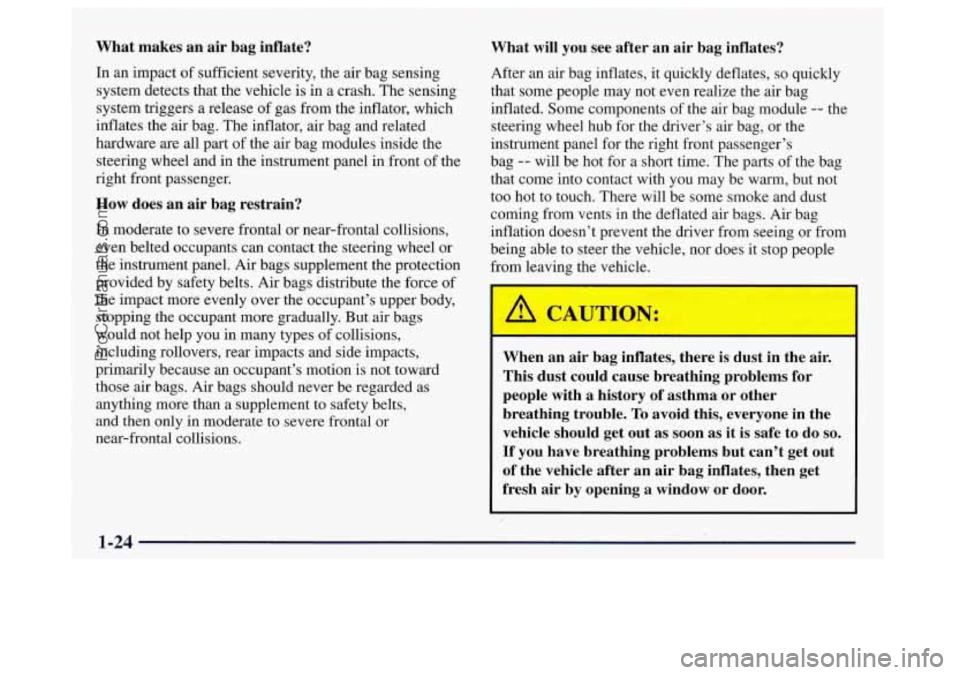
What makes an air bag inflate?
In an impact of sufficient severity, the air bag sensing
system detects that the vehicle is in a crash. The sensing
system triggers a release of gas from the inflator, which
inflates the air bag. The inflator, air bag and related
hardware are all part of the air bag modules inside the
steering wheel and in the instrument panel in front of the
right front passenger.
How does an air bag restrain?
In moderate to severe frontal or near-frontal collisions,
even belted occupants can contact the steering wheel or
the instrument panel. Air bags supplement the protection
provided by safety belts. Air bags distribute the force of
the impact more evenly over the occupant's upper body,
stopping the occupant more gradually. But air bags
would not help you in many types of collisions,
including rollovers, rear impacts and side impacts,
primarily because an occupant's motion is not toward
those air bags. Air bags should never be regarded as
anything more than a supplement to safety belts,
and then only in moderate to severe frontal
or
near-frontal collisions.
What will you see after an air bag inflates?
After an air bag inflates, it quickly deflates, so quickly
that some people may not even realize the air bag
inflated. Some components of the air bag module
-- the
steering wheel hub for the driver's air bag, or the
instrument panel for the right front passenger's
bag
-- will be hot for a short time. The parts of the bag
that come into contact with you may be warm, but not
too hot to touch. There will be some smoke and dust
coming from vents in the deflated air bags. Air bag
inflation doesn't prevent the driver from seeing or from
being able to steer the vehicle, nor does it stop people
from leaving the vehicle.
When an air bag inflates, there is dust in the air.
This dust could cause breathing problems for
people with a history of asthma or other
breathing trouble.
To avoid this, everyone in the
vehicle should get out as soon as it is safe
to do so.
If you have breathing problems but can't get out
of the vehicle after an air bag inflates, then get
fresh air by opening a window or door.
ProCarManuals.com
Page 39 of 380
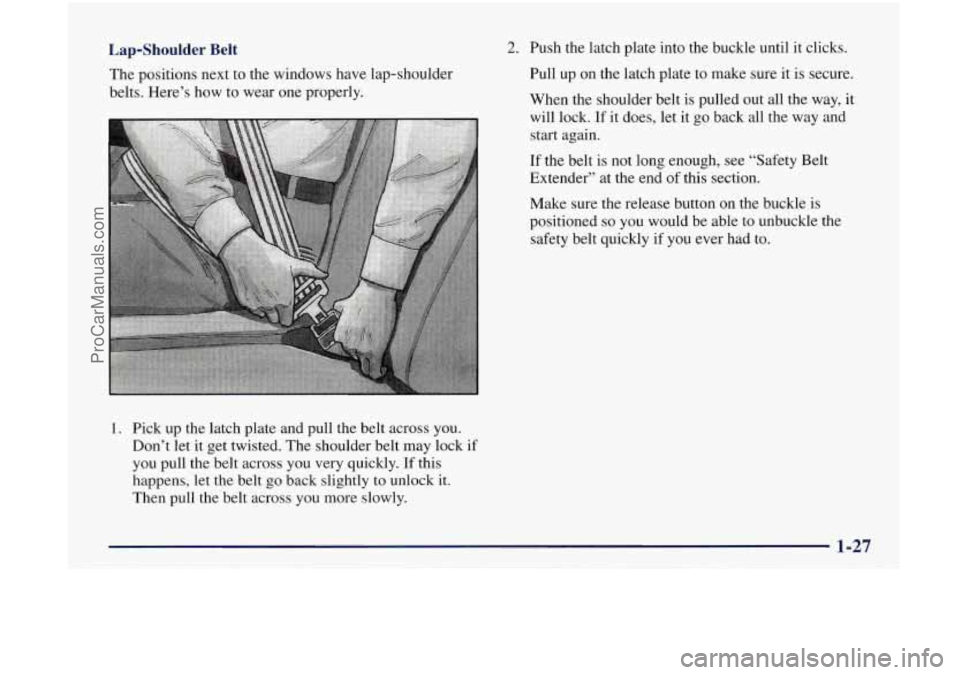
Lap-Shoulder Belt
The positions next to the windows have lap-shoulder
belts. Here’s how to wear one properly.
1. Pick up the latch plate and pull the belt across you.
Don’t let it get twisted. The shoulder belt may lock if
you pull the belt across you very quickly. If this
happens, let
the belt go back slightly to unlock it.
Then pull the belt across you more slowly.
2. Push the latch plate into the buckle until it clicks.
Pull up on the latch plate to make sure it is secure.
When the shoulder belt is pulled out all the way, it
will lock. If it does, let it go back all the way and
start again.
If the belt is not long enough, see “Safety Belt
Extender” at the end
of this section.
Make sure the release button on the buckle is
positioned
so you would be able to unbuckle the
safety belt quickly
if you ever had to.
1-27
ProCarManuals.com
Page 52 of 380
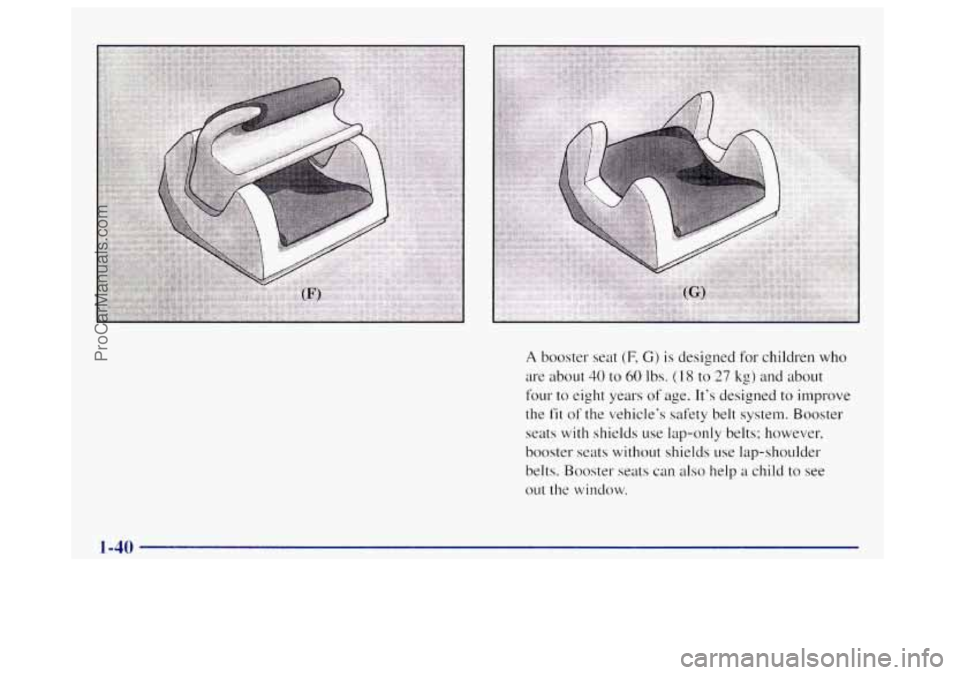
A booster seat (F, Gj is designed for children who
are about 40 to 60 lbs. ( 18 to 27 kg) and about
four to eight years
of age. It’s designed to improve
the
fit of the vehicle’s safety belt system, Booster
seats
with shields use lap-only belts; however,
booster seats without shields use lap-shoulder
belts. Booster seats can
also help a child to see
out the window.
ProCarManuals.com
Page 60 of 380
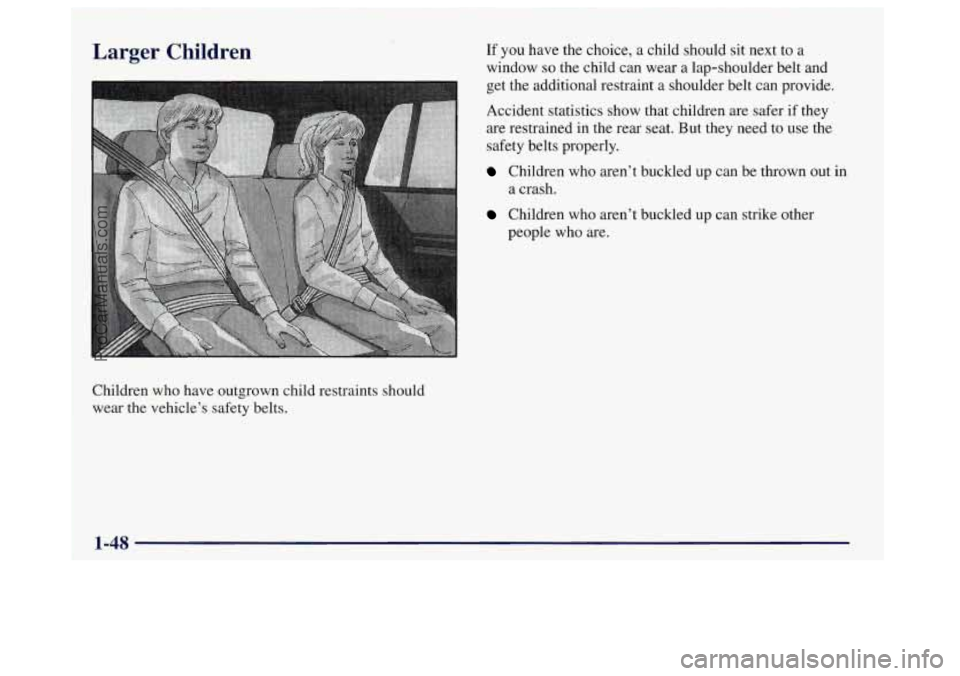
Larger Children If you have the choice, a child should sit next to a
window so the child can wear a lap-shoulder belt and
get the additional restraint a shoulder belt can provide.
Accident statistics show that children are safer if they
are restrained
in the rear seat. But they need to use the
safety belts properly.
Children who aren’t buckled up can be thrown out in
a crash.
Children who have outgrown child restraints should
wear the vehicle’s safety belts.
Children who aren’t buckled up can strike other
people who are.
1-48
ProCarManuals.com
Page 65 of 380
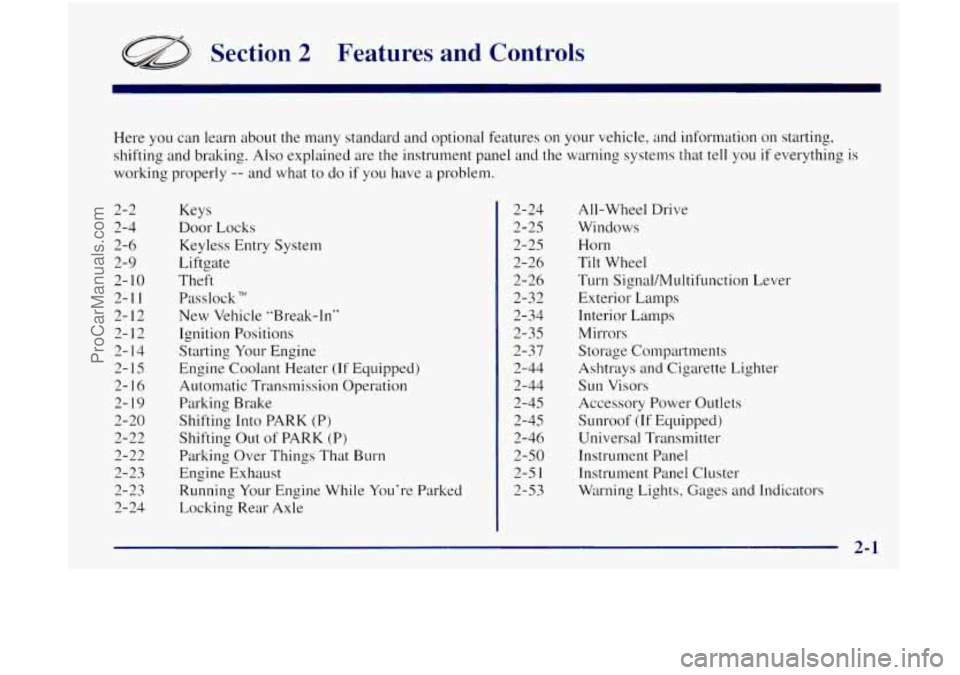
a Section 2 Features and Controls
Here you can learn about the many standard and optional features on your vehicle, and information on starting,
shifting and braking. Also explained are
the instrument panel and the warning systems that tell you if everything is
working properly
-- and what to do if you have a problem.
2-2
2-4
2-6
2-9
2-
10
2-1 1
2- 12 2- 12
2- 14
2- 15
2-16
2- 19
2-20
2-22
2-22
2-23
2-23
2- 24 Keys
Door Locks
Keyless Entry System
Liftgate
Theft Passlock
TM
New Vehicle “Break-In”
Ignition Positions
Starting Your Engine
Engine Coolant Heater
(If Equipped)
Automatic Transmission Operation
Parking Brake
Shifting Into PARK
(P)
Shifting Out of PARK (P)
Parking Over Things That Burn
Engine Exhaust
Running Your Engine While You’re Parked
Locking Rear Axle 2-24
2-25
2-25
2-26
2-26
2-32 2-34
2-35
2-37 2-44
2-44
2-45
2-45 2-46
2-50
2-5
1
2-53 All-Wheel Drive
Windows Horn
Tilt Wheel
Turn Signal/Multifunction Lever
Exterior Lamps
Interior Lamps
Mirrors
Storage Compartments Ashtrays and Cigarette Lighter
Sun Visors
Accessory Power Outlets
Sunroof (If Equipped)
Universal Transmitter Instrument Panel
Instrument Panel Cluster
Warning Lights, Gages and Indicators
ProCarManuals.com
Page 66 of 380

Keys
Leaving young children in a vehicle with the
ignition key
is dangerous for many reasons.
A child or others could be badly injured or
even killed.
They could operate power windows or other
controls or even make the vehicle move. Don’t
leave the keys
in a vehicle with young children.
ProCarManuals.com
Page 73 of 380

Liftgate
It can be dangerous to drive with the rear
window or liftgate open because carbon
monoxide (CO) gas can come into your vehicle.
You can’t see or snlell CO. It can cause
unconsciousness and even death.
If you must drive with the rear window or liftgate
open or if electrical wiring or other cable
connections must pass through the seal between
the body and the rear window or liftgate:
0 Make sure all windows are shut.
0 Turn the fan on your heating or coaling
system to its highest speed with the setting
on
VENT. That will force outside air into
your vehicle. See “Comfort Controls” in
the Index.
instrument panel, open them all the
way.
If you have air outlets on or under the
See “Engine Exhaust” in the Index.
Liftgate Release
There are several ways to release the liftgate. However,
the liftgate
will not release if the vehicle is in gear.
You can use your key
to unlock the liftgate from the
outside. Insert the key into
the liftgate lock button and
turn
it to the left. All doors will unlock.
You may
also use the Keyless Entry System
described earlier.
The liftgate can be opened without
a key if the driver’s
door
is unlocked.
To open the liftgate glass
only, ~~nlock the liftgate
and press the button.
To open the entire liftgate, unlock the liftgate and lift the
handle located
in the center of the door.
2-9
ProCarManuals.com
Page 74 of 380
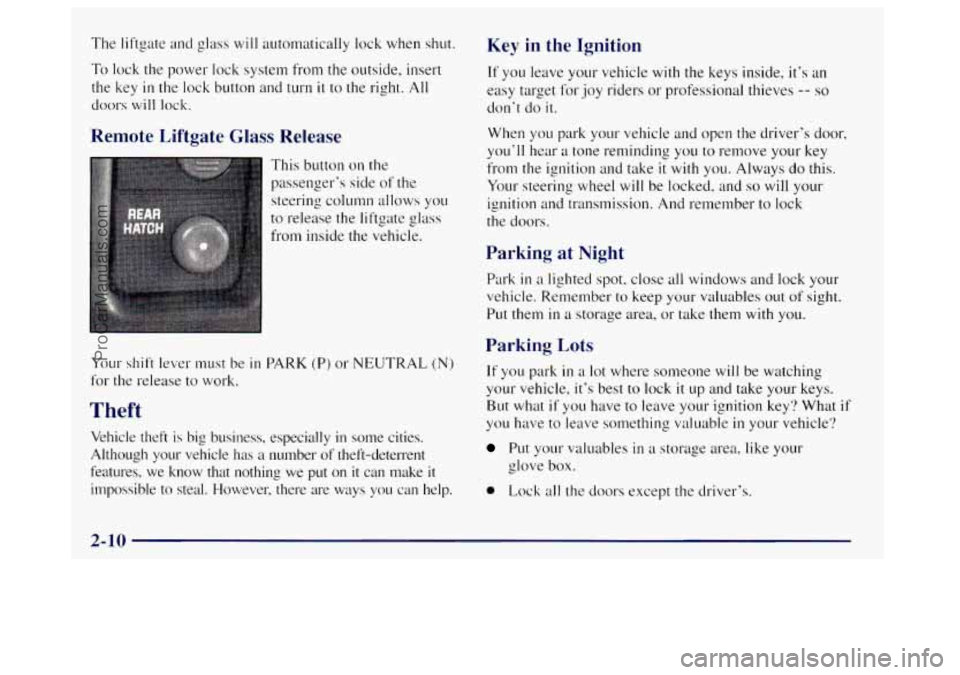
The liftgate and glass will automatically lock when shut.
To
lock the power lock system from the outside, insert
the key
in the lock button and turn it to the right. All
doors will lock.
Remote Liftgate Glass Release
This button on the
passenger’s side
of the
steering column allows you
to release the liftgate glass
from inside
the vehicle.
Key in the Ignition
If you leave your vehicle with the keys inside, it’s an
easy target for joy riders or professional thieves
-- so
don’t do it.
When you park your vehicle and open the driver’s door,
you’ll hear
a tone reminding you to remove your key
from the ignition
and take it with you. Always do this.
Your steering wheel
will be locked, and so will your
ignition and transmission. And remember to lock
the doors.
Parking at Night
Park in a lighted spot, close all windows and lock your
vehicle. Remember
to keep your valuables out of sight.
Put
them in a storage area, or take them with you.
Your shift lever must be
in PARK (P) or NEUTRAL (N)
for the release to work.
Theft
Vehicle theft is big business, especially in some cities.
Although your vehicle
has a number of theft-deterrent
features, we know that nothing we put
on it can make it
impossible to steal. However, there are ways you can help.
Parking Lots
If you park in a lot where someone will be watching
your vehicle, it’s best to lock
it up and take your keys.
But what
if you have to leave your ignition key‘? What if
you have to leave something valuable in your vehicle?
Put your valuables in a storage area, like your
glove box.
0 Lock all the doors except the driver’s.
2-10
ProCarManuals.com
Page 77 of 380
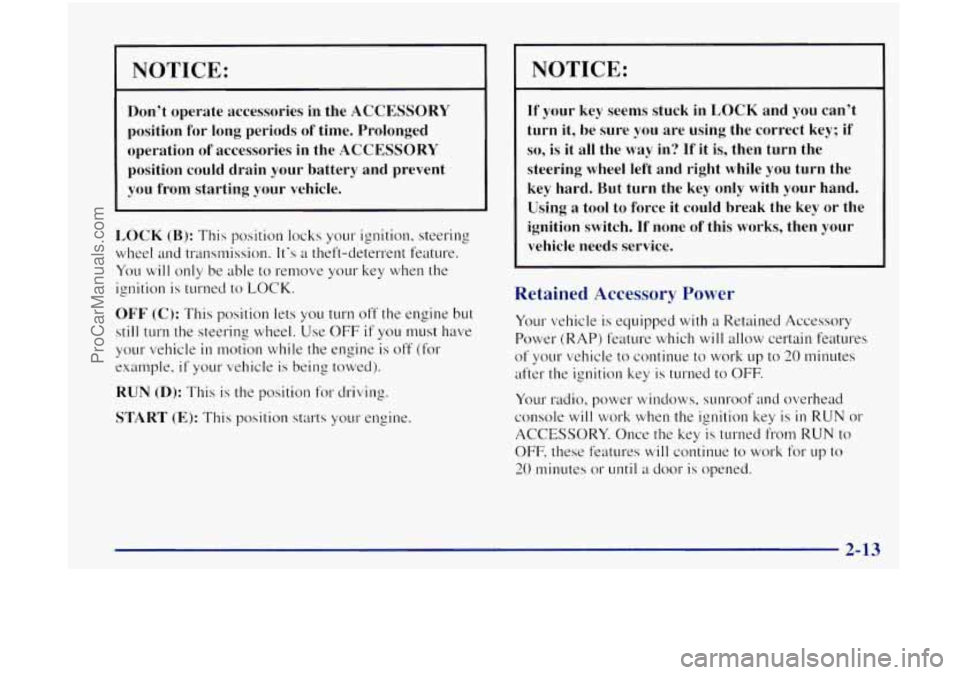
NOTICE:
Don’t operate accessories in the ACCESSORY
position for long periods of time. Prolonged
operation of accessories in the
ACCESSORY
position could drain your battery and prevent
you from starting your vehicle.
LOCK (B): This position locks your ignition, steering
wheel and transmission. It’s
a theft-deterrent feature.
You will only be able to remove your key when the
ignition is turned to
LOCK.
OFF (C): This position lets you turn off the engine but
still turn the steering wheel. Use
OFF if you must have
your vehicle
in motion while the engine is off (for
example,
if your vehicle is being towed).
RUN (D): This is the position for driving.
START (E): This position starts your engine.
NOTICE:
If your key seems stuck in LOCK and you can’t
turn it, be sure you are using the correct key; if
so, is it all the way in? If it is, then turn the
steering wheel left and right while you turn the
key hard. But turn the key only with your hand.
Using
a tool to force it could break the key or the
ignition switch.
If none of this works, then your
vehicle needs service.
Retained Accessory Power
Your vehicle is equipped with a Retained Accessory
Power (RAP) feature which will allow certain features
of your vehicle to continue to work up to 20 minutes
after the ignition
key is turned to OFF.
Your radio, power windows, sunroof and overhead
console
will work when the ignition key is in RUN or
ACCESSORY. Once the key is turned from
RUN to
OFF, these ,features will continue to work for up to
20 minutes or until a door is opened.
ProCarManuals.com